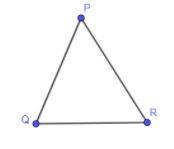
In this question, it is given that if $\angle P\ And \angle Q$ are complementary angles in a triangle PQR, then the measure of angle R is equal to:
(a) ${{45}^{\circ }}$
(b) ${{60}^{\circ }}$
(c) ${{75}^{\circ }}$
(d) ${{90}^{\circ }}$
Answer
573k+ views
Hint: We have given that $\angle P\ And \angle Q$ as complementary angles of a triangle PQR then we have to find the measure of angle R. We know that if two angles are complementary, it means that sum of these two angles are ${{90}^{\circ }}$ then sum of $\angle P\ And \angle Q$ is ${{90}^{\circ }}$ and we also know that sum of all the angles of a triangle is ${{180}^{\circ }}$ then if we subtract these two angles $\angle P\And \angle Q$ then we will get the measure of angle R.
Complete step-by-step answer:
In the above problem, we have given a triangle PQR in which $\angle P\And \angle Q$ are complementary angles and we have to find the measurement of angle R.
In the below figure, we have drawn a triangle PQR,

Now, in this triangle we have given $\angle P\And \angle Q$ as complementary and we know that sum of two complementary angles is ${{90}^{\circ }}$ so adding $\angle P\And \angle Q$ and then equating it to ${{90}^{\circ }}$ we get,
$\angle P+\angle Q={{90}^{\circ }}$
We also know that sum of all the angles of a triangle is ${{180}^{\circ }}$ so adding all the angles P, Q and R and equating them to ${{180}^{\circ }}$ we get,
$\angle P+\angle Q+\angle R={{180}^{\circ }}$
Now, substituting the measurement of summation of angles P and Q as ${{90}^{\circ }}$ we get,
${{90}^{\circ }}+\angle R={{180}^{\circ }}$
Subtracting ${{90}^{\circ }}$ on both the sides we get,
$\begin{align}
& \angle R={{180}^{\circ }}-{{90}^{\circ }} \\
& \Rightarrow \angle R={{90}^{\circ }} \\
\end{align}$
Hence, we got the measurement of angle R as ${{90}^{\circ }}$.
So, the correct answer is “Option d”.
Note: The point to be noted here, don’t confuse complementary with supplementary because when two angles are supplementary then their sum is ${{180}^{\circ }}$. You can prevent this confusion in this problem as supplementary angles sum is ${{180}^{\circ }}$ and we know that sum of all the three angles of a triangle is ${{180}^{\circ }}$. Now, if you mistakenly write the sum of two complementary angles as ${{180}^{\circ }}$ then the third angle becomes ${{0}^{\circ }}$ and if the third angle becomes ${{0}^{\circ }}$ in a triangle then the three angles are not making a triangle so here, you will correct yourself and write the complementary angles sum as ${{90}^{\circ }}$ because it will make the third angle non zero and is preventing the condition for three angles to make a triangle.
Complete step-by-step answer:
In the above problem, we have given a triangle PQR in which $\angle P\And \angle Q$ are complementary angles and we have to find the measurement of angle R.
In the below figure, we have drawn a triangle PQR,

Now, in this triangle we have given $\angle P\And \angle Q$ as complementary and we know that sum of two complementary angles is ${{90}^{\circ }}$ so adding $\angle P\And \angle Q$ and then equating it to ${{90}^{\circ }}$ we get,
$\angle P+\angle Q={{90}^{\circ }}$
We also know that sum of all the angles of a triangle is ${{180}^{\circ }}$ so adding all the angles P, Q and R and equating them to ${{180}^{\circ }}$ we get,
$\angle P+\angle Q+\angle R={{180}^{\circ }}$
Now, substituting the measurement of summation of angles P and Q as ${{90}^{\circ }}$ we get,
${{90}^{\circ }}+\angle R={{180}^{\circ }}$
Subtracting ${{90}^{\circ }}$ on both the sides we get,
$\begin{align}
& \angle R={{180}^{\circ }}-{{90}^{\circ }} \\
& \Rightarrow \angle R={{90}^{\circ }} \\
\end{align}$
Hence, we got the measurement of angle R as ${{90}^{\circ }}$.
So, the correct answer is “Option d”.
Note: The point to be noted here, don’t confuse complementary with supplementary because when two angles are supplementary then their sum is ${{180}^{\circ }}$. You can prevent this confusion in this problem as supplementary angles sum is ${{180}^{\circ }}$ and we know that sum of all the three angles of a triangle is ${{180}^{\circ }}$. Now, if you mistakenly write the sum of two complementary angles as ${{180}^{\circ }}$ then the third angle becomes ${{0}^{\circ }}$ and if the third angle becomes ${{0}^{\circ }}$ in a triangle then the three angles are not making a triangle so here, you will correct yourself and write the complementary angles sum as ${{90}^{\circ }}$ because it will make the third angle non zero and is preventing the condition for three angles to make a triangle.
Recently Updated Pages
In cricket, what is a "pink ball" primarily used for?

In cricket, what is the "new ball" phase?

In cricket, what is a "death over"?

What is the "Powerplay" in T20 cricket?

In cricket, what is a "super over"?

In cricket, what is a "tail-ender"?

Trending doubts
Why is there a time difference of about 5 hours between class 10 social science CBSE

Who was the first woman to receive Bharat Ratna?

Write a letter to the principal requesting him to grant class 10 english CBSE

What is the median of the first 10 natural numbers class 10 maths CBSE

The Equation xxx + 2 is Satisfied when x is Equal to Class 10 Maths

Who Won 36 Oscar Awards? Record Holder Revealed




